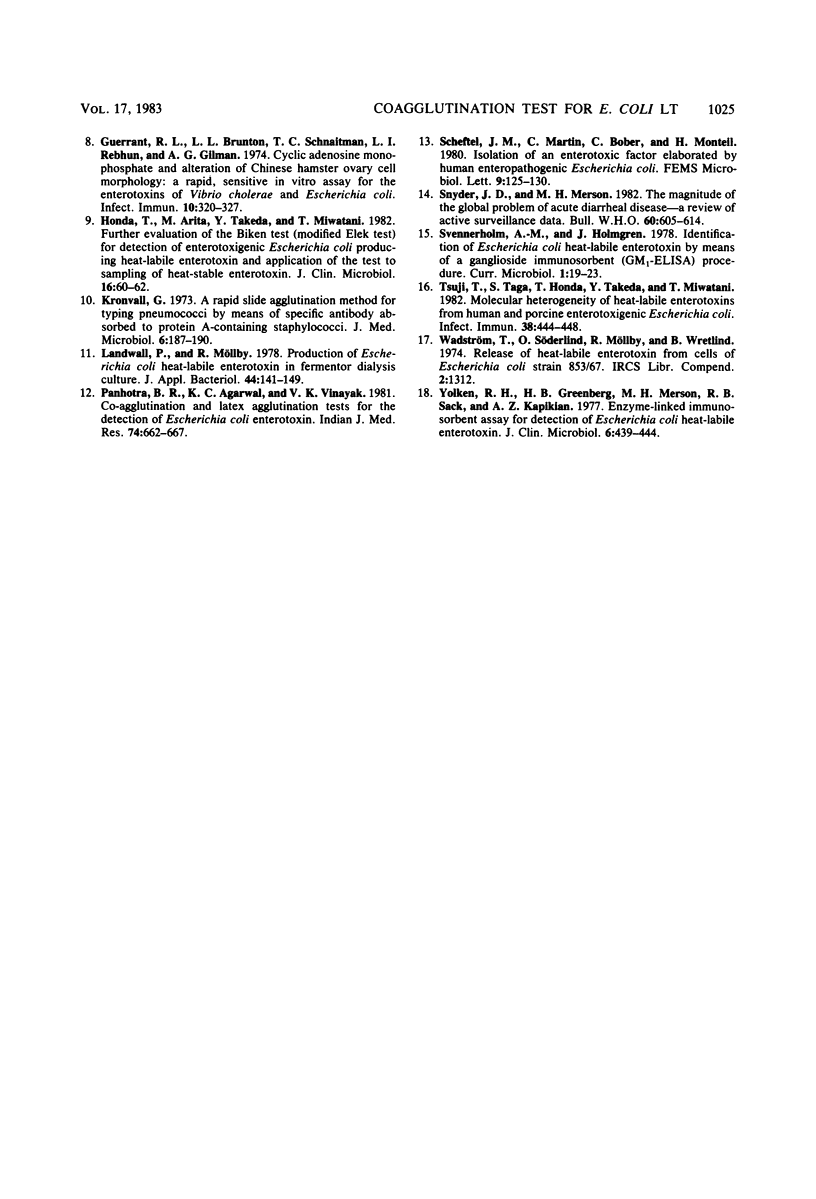Abstract
Colonies of Escherichia coli from blood agar plates were suspended and lysed in saline containing polymyxin B and a detergent (Triton X-100). The lysates were assayed for heat-labile enterotoxin (LT) by a coagglutination test (coa-test). The coa-test reagent consisted of Formalin-treated and heat-killed cells of Staphylococcus aureus, strain Cowan 1, sensitized with a high-titer rabbit anti-LT serum. Purified LT was detected in the coa-test at the nanogram level (2 to 5 ng), whereas larger amounts of cholera toxin (50 ng) were required to give a positive test. The coa-test was compared with the CHO cell test for detection of LT among E. coli strains isolated from human and animal stool cultures. The results of the coa-test and the CHO cell test correlated with 63 of 67 strains of human origin. Six of nine animal strains, defined as LT positive by the CHO cell test, gave positive results in the coa-test. We conclude that the coa-test is probably accurate and sensitive enough to be used in routine diagnosis of LT-producing E. coli strains isolated from human stool cultures. No special laboratory equipment is required, which makes the coa-test suited for diagnosis of enterotoxigenic E. coli in small hospital laboratories and in developing countries.
Full text
PDF




Images in this article
Selected References
These references are in PubMed. This may not be the complete list of references from this article.
- Brill B. M., Wasilauskas B. L., Richardson S. H. Adaptation of the staphylococcal coagglutination technique for detection of heat-labile enterotoxin of Escherichia coli. J Clin Microbiol. 1979 Jan;9(1):49–55. doi: 10.1128/jcm.9.1.49-55.1979. [DOI] [PMC free article] [PubMed] [Google Scholar]
- Bäck E., Möllby R., Kaijser B., Stintzing G., Wadström T., Habte D. Enterotoxigenic Escherichia coli and other gram-negative bacteria of infantile diarrhea: surface antigens, hemagglutinins, colonization factor antigen, and loss of enterotoxigenicity. J Infect Dis. 1980 Sep;142(3):318–327. doi: 10.1093/infdis/142.3.318. [DOI] [PubMed] [Google Scholar]
- Clements J. D., Finkelstein R. A. Isolation and characterization of homogeneous heat-labile enterotoxins with high specific activity from Escherichia coli cultures. Infect Immun. 1979 Jun;24(3):760–769. doi: 10.1128/iai.24.3.760-769.1979. [DOI] [PMC free article] [PubMed] [Google Scholar]
- Geary S. J., Marchlewicz B. A., Finkelstein R. A. Comparison of heat-labile enterotoxins from porcine and human strains of Escherichia coli. Infect Immun. 1982 Apr;36(1):215–220. doi: 10.1128/iai.36.1.215-220.1982. [DOI] [PMC free article] [PubMed] [Google Scholar]
- Goebel W., Hedgpeth J. Cloning and functional characterization of the plasmid-encoded hemolysin determinant of Escherichia coli. J Bacteriol. 1982 Sep;151(3):1290–1298. doi: 10.1128/jb.151.3.1290-1298.1982. [DOI] [PMC free article] [PubMed] [Google Scholar]
- Greenberg H. B., Sack D. A., Rodriguez W., Sack R. B., Wyatt R. G., Kalica A. R., Horswood R. L., Chanock R. M., Kapikian A. Z. Microtiter solid-phase radioimmunoassay for detection of Escherichia coli heat-labile enterotoxin. Infect Immun. 1977 Sep;17(3):541–545. doi: 10.1128/iai.17.3.541-545.1977. [DOI] [PMC free article] [PubMed] [Google Scholar]
- Guerrant R. L., Brunton L. L., Schnaitman T. C., Rebhun L. I., Gilman A. G. Cyclic adenosine monophosphate and alteration of Chinese hamster ovary cell morphology: a rapid, sensitive in vitro assay for the enterotoxins of Vibrio cholerae and Escherichia coli. Infect Immun. 1974 Aug;10(2):320–327. doi: 10.1128/iai.10.2.320-327.1974. [DOI] [PMC free article] [PubMed] [Google Scholar]
- Honda T., Arita M., Takeda Y., Miwatani T. Further evaluation of the Biken test (modified Elek test) for detection of enterotoxigenic Escherichia coli producing heat-labile enterotoxin and application of the test to sampling of heat-stable enterotoxin. J Clin Microbiol. 1982 Jul;16(1):60–62. doi: 10.1128/jcm.16.1.60-62.1982. [DOI] [PMC free article] [PubMed] [Google Scholar]
- Kronvall G. A rapid slide-agglutination method for typing pneumococci by means of specific antibody adsorbed to protein A-containing staphylococci. J Med Microbiol. 1973 May;6(2):187–190. doi: 10.1099/00222615-6-2-187. [DOI] [PubMed] [Google Scholar]
- Landwall P., Möllby R. Production of Escherichia coli heat-labile enterotoxin in fermenter dialysis culture. J Appl Bacteriol. 1978 Feb;44(1):141–149. doi: 10.1111/j.1365-2672.1978.tb00785.x. [DOI] [PubMed] [Google Scholar]
- Panhotra B. R., Agarwal K. C., Vinayak V. K. Co-agglutination and latex agglutination tests for the detection of Escherichia coli enterotoxin. Indian J Med Res. 1981 Nov;74:662–667. [PubMed] [Google Scholar]
- Snyder J. D., Merson M. H. The magnitude of the global problem of acute diarrhoeal disease: a review of active surveillance data. Bull World Health Organ. 1982;60(4):605–613. [PMC free article] [PubMed] [Google Scholar]
- Tsuji T., Taga S., Honda T., Takeda Y., Miwatani T. Molecular heterogeneity of heat-labile enterotoxins from human and porcine enterotoxigenic Escherichia coli. Infect Immun. 1982 Nov;38(2):444–448. doi: 10.1128/iai.38.2.444-448.1982. [DOI] [PMC free article] [PubMed] [Google Scholar]
- Yolken R. H., Greenberg H. B., Merson M. H., Sack R. B., Kapikian A. Z. Enzyme-linked immunosorbent assay for detection of Escherichia coli heat-labile enterotoxin. J Clin Microbiol. 1977 Nov;6(5):439–444. doi: 10.1128/jcm.6.5.439-444.1977. [DOI] [PMC free article] [PubMed] [Google Scholar]



